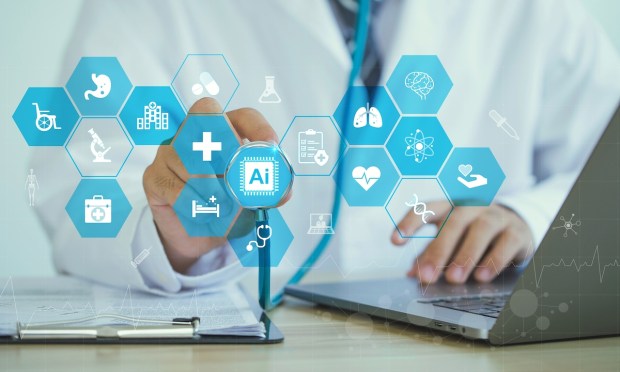
Throughout history, some of the world’s greatest problems have also been businesses’ greatest opportunities.
Fast-forward to today, and makers of artificial intelligence systems are already moving to apply the intelligent computing innovation’s change-the-game potential for efficiency capture and process improvement across some of the most historically siloed and fragmented sectors — like America’s vast and disjointed healthcare industry.
Alphabet-owned Google introduced Wednesday (Dec. 13) a new family of generative AI models fine-tuned for the healthcare industry, called MedLM.
“Improving healthcare and medicine are among the most promising use cases for artificial intelligence,” Google wrote in a blog post, noting that MedLM offers healthcare organizations two separate foundational models built on domain-specific data and designed to meet different operational and care-centered needs.
“Healthcare organizations are exploring the use of AI for a range of applications, from basic tasks to complex workflows,” per the blog post. “Through piloting our tools with different organizations, we’ve learned the most effective model for a given task varies depending on the use case. For example, summarizing conversations might be best handled by one model, and searching through medications might be better handled by another.”
The first MedLM model being offered is larger and designed for more complex workflows, while the second MedLM model is a “medium model,” which was purpose-built to be further fine-tuned depending on an organization’s needs.
Healthcare is a giant sector with many segments — and there exist different roles AI can play across the ecosystem that come weighted with different risks and different opportunities.
Beyond just the healthcare space, Google’s approach of providing domain-specific models that can built out further with task-oriented training offers clues into how enterprise AI can be best monetized and scaled in the future.
Read also: Can Always-On AI Give Healthcare Providers a Helping Hand?
“AI has been revolutionizing medicine over the last few decades,” Forward CEO Adrian Aoun told PYMNTS in an interview posted this month. “The problem is that it hasn’t been doing it in the ways that we care about.
“Things need to be built for a world of AI in order for that AI to work and scale,” he added.
AI has been in the works for decades, about 75 years, and generative AI’s prior, statistically predictive iterations have long been put to work optimizing healthcare insurance pricing and streamlining healthcare system operations with other algorithms humming in the background.
Many of the latest AI innovations are looking to bring AI interfaces into the foreground by helping doctors glean insights from healthcare data in real time and allowing users to find accurate clinical information more efficiently.
Despite the potential benefits of AI in healthcare, PYMNTS Intelligence found that 60% of adults remain uncomfortable with the idea of AI-driven healthcare decisions. Concerns range from biases in AI algorithms to fears that AI may lead to worse outcomes.
“One of the threshold concerns is that the data sets being worked on for analytical purposes are not applicable to the individual in question,” Tom O’Neil, managing director at Berkeley Research Group and former chief compliance officer at Cigna, told PYMNTS in an interview posted in November. “I think that’s a big issue, and it is better to get out there and talk about it than to surround it with an aura of mystery.”
Deploying generative AI across an area as critical as care delivery requires certain guardrails that have been made only voluntarily by domestic tech firms, with AI development in the U.S. taking place absent any binding policies.
Still, there exists an attractive and vast white space opportunity to supplement entrenched and manual healthcare processes with generative AI models that aid workers in completing their tasks.
See also: Healthcare Looks to AI for Potential Home Run Hit
As PYMNTS’ Karen Webster wrote at the beginning of the year, AI’s greatest potential is in creating the knowledge base needed to equip the workforce — any worker in any industry — with the tools to deliver a consistent, high-quality level of service, quickly and at scale.
This is particularly true within healthcare, as tailoring AI solutions by industry is increasingly proving to be key to scalability.
“Worldwide, very few people have access to doctors — and the opportunity to have an AI doctor, even if they have just 30%, 50% of an average provider’s knowledge and capability, is still a massive value add,” Beerud Sheth, CEO at conversational AI platform Gupshup, told PYMNTS in an interview posted in November.
It’s not hard to imagine a future where healthcare systems might offer bespoke generative AI products for a range of ailments. Patients with a cold or flu would interact with a respiratory illness-trained AI, for example, while those with abrasions or cuts would be directed to an AI system trained to interact with pictures and images of the issue at hand.
Just as doctors are trained in their specialties, so too might the AI healthcare systems of tomorrow.
Still, as PYMNTS Intelligence found, there exists a growing urban-rural divide in access to and participation in digital healthcare services. This gap between access to care and the ability of care to be delivered will need to be addressed — and ideally closed.
For all PYMNTS AI coverage, subscribe to the daily AI Newsletter.